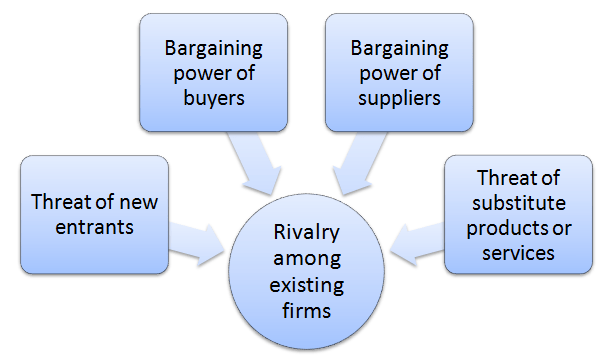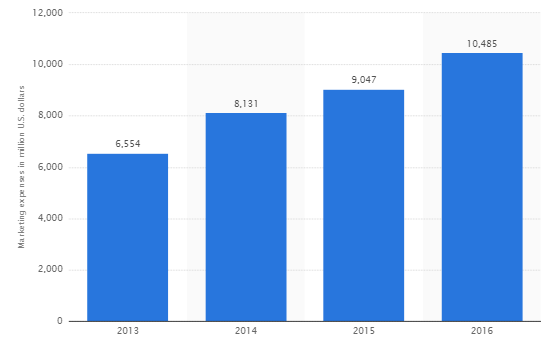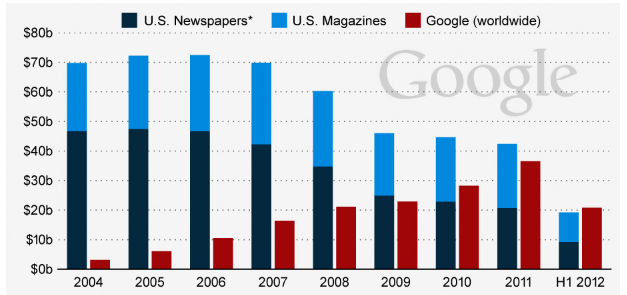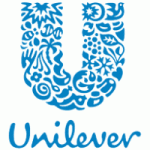
Porter’s Five Forces analytical framework developed by Michael Porter (1979)[1] represents five individual forces that shape the overall extent of competition in the industry. Google Porter’s Five Forces are represented in Figure 1 below: Figure 1 Google Porter’s Five Forces Threat of substitute products or services for Google is low. Search remains as Google’s and Alphabet’s core business and it is used by more than a billion people around the globe every day. The threat of substitute for Google’s search can be assessed as low because it remains to be the most convenient and time-efficient way of finding needed information. The threat of substitute products and services for Google’s other services is moderate. For example, people can use mobile text messages or mobile messengers such as What’s Up instead of using Gmail and traditional paper maps can be used instead of Google maps. At the same time, it is important to note that although, there are some direct and indirect substitutes for all Google services, these substitutes do not offer the same level of user convenience, functionality and speed. Accordingly, the threat of substitute products and services for products and services offered by Google can be generally assessed as low. Rivalry among existing firms is fierce. General purpose search engines and information services, such as Microsoft’s Bing, Yahoo, Yandex, Baidu, Naver, and Seznam represent competition for Google search. There are also vertical search engines and e-commerce websites, such as Amazon and eBay (e-commerce), Kayak (travel queries), LinkedIn (job queries), and WebMD (health queries). Some users will navigate directly to such content, websites, and apps rather than go through Google. Social networks, such as Facebook and Twitter also belong to the list of Google competitors. Some users are increasingly relying on social networks for product or service referrals, rather than seeking…

Alphabet (Google) marketing strategy integrates various online and offline marketing techniques. Alphabet’s marketing budgets and efforts mainly focus on main business – Google. It has been noted that “though you’ll never see an ad for the king of the search engines, this query behemoth employs some of the most subtle, yet fantastically impressive marketing strategies out there”[1] Beyond Google, Alphabet Inc. does not invest much resources and efforts to advertise its other projects such as Access, Calico, CapitalG, GV, Nest, Verily, Waymo, and X. This is because most of these projects are only on the stage of research and development and they do not have products and services ready to offer to the market. As it is illustrated in Figure 4 below, total annual marketing spending of the company has been consistently increasing during the past several years. Out of these amounts, for the years ended December 31, 2014, 2015 and 2016, advertising and promotional expenses totalled approximately USD3,004 million, USD3,186 million, and USD3,868 million, respectively[2]. Annual Alphabet Inc. (Google) marketing spending[3] Google marketing strategy is based on the following principles: Within the framework of marketing mix, focusing on product element to a greater extent compared to other elements. The majority of Alphabet products and services are innovative in their nature or they add innovative features to existing products and services. Targeting the broadest customer segment with multiple products and services. The company’s core business, Google offers a wide range of products and services such as Search, Android, Maps, Chrome, YouTube, Google Play, and Gmail that are used by billions of people every day worldwide. Using several elements of marketing communications mix in an integrated manner. Specifically, the internet giant uses sales promotion, events and experiences, public relations and direct marketing tools to company to communicate its marketing message to…

Google marketing communication mix explains the ways in which advertising, sales promotion, events and experiences, public relations and direct marketing tools are used by the company to communicate its marketing message to the target customer segment. Advertising Google emerged as a popular alternative for traditional print and media advertising and changed advertising industry worldwide to a great extent. As it is illustrated in figure below, by 2012 Google was generating more advertising revenues than print media in the US as a whole. The significance and market share of Google in the global advertising industry has increased even to a greater extent during the past five years, since 2012. Accordingly, owning a more significant advertising platform than print and media advertising, Google does not use traditional print and media advertising to communicate its marketing message to the target customer segment. Revenues by print media in the US and Google (worldwide)[1] Sales Promotion Sales promotion refers to the “stimulation of sales achieved through contests, demonstrations, discounts, exhibitions or trade shows, games, giveaways, point-of-sales displays and merchandising, special offers and similar activities”[2]. Google employs sales promotion marketing techniques rarely. The most noteworthy case relates to one day sales promotion of Google Glass via online purchase for USD1,500[3] and the promotion of Android 4.4 in cooperation with candy bar KitKat, owned by Nestle International Travel Retail. Up to date Google does not use popular sales promotions techniques such as seasonal sales promotions, money off coupons, competitions, discount vouchers, free gifts or loyalty cards… Alphabet Inc. (Google) Report contains a full analysis of Google marketing communication mix and Google marketing strategy in general. The report illustrates the application of the major analytical strategic frameworks in business studies such as SWOT, PESTEL, Porter’s Five Forces, Value Chain analysis and McKinsey 7S Model on Google. Moreover, the report…

Alphabet (Google) segmentation, targeting and positioning efforts can be explained as the essence of company’s marketing efforts. Segmentation divides population into groups on the basis of specific characteristics. Targeting refers to choosing certain groups identified as a result of segmentation to sell products and services. Lastly, positioning refers to the selection of the marketing mix the most suitable for the target customer segment. Google uses the following types of positioning: Multi-segment positioning. The company offers a wide range of products and services such as Search, Android, Maps, Chrome, YouTube, Google Play, and Gmail that target multiple customer segments Standby positioning. Certain products within Alphabet portfolio such as robotics, Waymo self-driving cars, Lunar XPRIZE space exploration program, 3D mapping and others may not have a clear target customer segment at this stage. Nevertheless, these products and projects are awaiting changes in the market for the demand to emerge. Imitative positioning. Google has used imitative positioning in a few instances. The launch of Chrome browser to imitate then-market leader Internet Explorer and the launch of G+ social networking site to imitate Facebook can be mentioned to illustrate this point. The following table illustrates Google segmentation, targeting and positioning: Type of segmentation Segmentation criteria Google target customer segment Geographic Region Global scale Density Urban and rural Demographic Age Anyone older than 12 years old Gender Males & Females Life-cycle stage Bachelor Stage young, single people not living at home Newly Married Couples young, no children Full Nest I youngest child under six Full Nest II youngest child six or over Full Nest III older married couples with dependent children Empty Nest I older married couples, no children living with them Empty Nest II older married couples, retired, no children living at home Solitary Survivor I in labour force Solitary Survivor II retired…

Alphabet (Google) marketing mix, also referred to as Alphabet (Google) 7Ps of marketing comprises elements of the marketing mix that consists of product, place, price, promotion, process, people and physical evidence. Product. Alphabet Inc. is a holding company and its portfolio comprises nine companies. Products and services offered by these companies are illustrated in table below: Company Products and services Google Search, Android, Maps, Chrome, YouTube, Google Play, and Gmail Waymo Self-driving cars Verily Miniaturized CGM, Smart Lens Program, Debug, Retinal Imaging etc. Calico Research and development projects focused on ageing Nest Indoor and outdoor cameras, learning thermostats, and smoke alarms Access High-speed fiber internet access across the U.S X Projects associated with “moonshot” technologies Capital G Equity investment fund GV Venture capital Companies in Alphabet portfolio and products and services offered by them It is important to note that although Alphabet product portfolio is vast and diverse, Google remains as its core business accounting for 88% of total revenues in 2016 through advertising[1] Place. Being an e-commerce and internet company, Google relies on online sales channel for the sales of its products and services. In 2015 the company opened its first physical store and up to date, there are only a few Google physical stores in various formats in North America and the UK. Google’s first physical store in London, is a “shop in a shop” located inside the Currys PC World store on Tottenham Court. “In addition to showcasing Google merchandise—Chromebooks, Chromecasts, Android phones, and so on—the space includes a “Doodle Wall” for customers to scribble on with digital spray paint, a “Chromecast Pod” for movie viewing, and a “Portal” for touring the planet via Google Earth.”[2] It has to be noted that place element of the marketing mix does not relate to certain companies belonging to Alphabet portfolio…

Founded by Stanford University students Larry Page and Sergey Brin in 1998, Google dominates almost all of its markets and the company is well-known for its culture of creativity and innovative approach to develop new products and services. Google offers a wide range of interrelated internet-based products and services that are aimed at satisfying personal and professional needs in terms of communication, recreation, organization and increasing the level of performance and effectiveness. Google Inc. was restructured in 2015 to become Alphabet Inc. “Google’s search product became a wholly owned subsidiary of a new parent company, Alphabet, with other Google projects and teams spun out into separate “Alphabet companies,” each with its own CEO.”(Price and Nudelman, 2016, online). Alphabet Inc. is a holding company with no business operations of its own. Google is the largest business within Alphabet Inc. product portfolio. The company’s product portfolio also comprises Access, Calico, CapitalG, GV, Nest, Verily, Waymo, and X. The company classifies it’s all non-Google businesses as Other Bets. In fiscal year 2016, Alphabet Inc. generated revenues of USD90.3 billion and revenue growth of 20% year over year, with constant currency revenue growth of 24% year over year. Google segment generated revenues of USD89.5 billion, with revenue growth of 20% year over year. Other Bets revenues of USD0.8 billion with revenue growth of 82% year over year. Revenues from the United States, the United Kingdom, and Rest of the world were USD42.8 billion, USD7.8 billion, and USD39.7 billion, respectively (Annual Report,2016). The company has more than 72,000 full-time employees worldwide. Google core business strategy is business diversification and introduction of new products and services in a regular manner. Google business strategy is also based on the development of a closed eco-system to motivate customers to use greater range of products and services. Customers usually…

The table below illustrates Unilever SWOT analysis template Strengths 1. Ownership of more than 400 brands, including globally well-known brands such as Lipton, Dove, Sunsilk, AXE, Lynx and others. 2. Benefiting extensively from the economies of scale due to the extensive scope of operations 3. Highly sophisticated product distribution strategies with about 270 manufacturing sites located strategically around the globe 4. Effective R&D strategy with substantial funding that ensures the pipeline of new products in a regular manner Weaknesses 1. Existence of a wide range of substitutes for the majority of Unilever products 2. Lack of flexibility of the company and difficulties in implementing changes due to its massive size 3. Negative implications of animal testing practices on the brand image 4. Increasing costs of resources for Uniliver is expected to continue Opportunities 1. International market expansion with the focus on emerging economies 2. Investing in improving health implications of Unilever hygiene and beauty products 3. Engagement in business diversification strategy and establishing presence in services sector 4. Focusing on improving CSR image of the business via introducing relevant programs and initiatives Threats 1. Further increase in the costs of resources 2. Increasing popularity of own brands by supermarket chains 3. Emergence of scandals related to negative health implications for caused by Unilever products 4. Introduction of trade barriers in international markets for Unilever How to use Unilever SWOT Analysis template above Expand each point above into one or more paragraphs with discussions and analysis. Additional points related to Unilever strengths, weaknesses, opportunities and threats not listed above can also be included if you think they are relevant points and add value to the work. You will need to support your arguments with references from reliable sources such as annual report of the company, industry journals and magazines and government…
By John Dudovskiy
Category: Beauty & Fashion

The table below illustrates H&M SWOT analysis template Strengths 1. Value proposition of style for affordable prices 2. High speed of new product development. The timeframe for new products to reach shop shelves from design stage is limited to 12 weeks 3. Benefiting from the economies of scale due to the large scope of operations 4. Efficient application of celebrity endorsement marketing strategy via attracting Katy Perry, David Beckham, Madonna and others Weaknesses 1. Weak utilization of online sales channel 2. Vulnerability to overstocking due to the practice of producing high quantities of items with no guarantees of sale 3. Lack of control over the manufacturing of products 4. The practice of following fashion trends set by competitors rather than setting own fashion trends Opportunities 1. Placing a greater focus on online sales channel 2. Expanding the target customer segment to comprise middle-aged and older customers 3. Entering into strategic cooperation with well-known designers 4. Increasing presence in developing counties especially China, India and former USSR-blog countries Threats 1. Weak economic situation in Europe is negatively impacting purchasing power of the target customer segment 2. Risks of supply-chain issues due to the long distance between suppliers from developing countries and shops 3. Emergence of new competitors with access to cheaper resources 4. Decline in the quality of products due to the further pursuit of cost leadership How to use H&M SWOT Analysis template above Expand each point above into one or more paragraphs with discussions and analysis. Additional points related to H&M strengths, weaknesses, opportunities and threats not listed above can also be included if you think they are relevant points and add value to the work. You will need to support your arguments with references from reliable sources such as annual report of the company, industry journals and magazines and…
By John Dudovskiy
Category: Beauty & Fashion

The table below illustrates Johnson & Johnson SWOT analysis template Strengths 1. High level of brand awareness and a brand value of USD 312.6 billion as of May 2016 according to Forbes[1] 2. Benefiting from economies of scale due to the global extensive scope of operations 3. Efficient delivery of marketing communication message across a wide range of communication channels in an integrated manner 4. Broad, yet focused brand portfolio Weaknesses 1. Damage to the brand image due to series of CSR-related scandals such as the use of formaldehyde the payment of more than £50 million to the family of Jacqueline Fox due to the cancer case[2] 2. A history of product recalls of more than 40 medicines 3. Lack of flexibility of the business due to its large size of the company 4. A history of engagement in many litigation cases over the years with negative implications on the brand image Opportunities 1. Avoiding the usage of harmful ingredients in products 2. Focusing on restoring the image via effective CSR programs and initiatives 3. Formation of strategic alliances with health companies 4. Finding and exploiting new sources of competitive advantage Threats 1. Risks of new scandals caused by negative health implications associated with the use of Johnson & Johnson products 2. Emergence of new spurious companies in developing countries with the brand names similar to Johnson & Johnson 3. Increasing ranges of substitutes products and competitors with lower prices 4. Certain products can be banned in certain countries due to health concerns How to use Johnson & Johnson SWOT Analysis template above Expand each point above into one or more paragraphs with discussions and analysis. Additional points related to Johnson & Johnson strengths, weaknesses, opportunities and threats not listed above can also be included if you think they are relevant…
By John Dudovskiy
Category: Beauty & Fashion

The table below illustrates Walt Disney SWOT analysis template Strengths 1. High level of brand awareness and positive brand reputation 2. Focused portfolio of brands 3. Solid financial position with about USD 5 billion reserves as of April 2016 4. Experience in successfully leveraging popular characters Mickey Mouse, Donald Duck, Cinderella and Frozen into movies, theme park attraction and in some cases, musicals Weaknesses 1. Overdependence on North America home market 2. Declining financial performance of ESPN multimedia entertainment branch 3. High level of seasonality of the business 4. Narrow target audience i.e. children Opportunities 1. Growth of entertainment industry in developing countries 2. Taking into account cross-cultural differences among global consumers to a greater extent in the development process of entertainment products and services 3. Increasing the scope of target customer segment by developing entertainment products for middle-aged consumers 4. Increasing focus on the development of digital products Threats 1. Growing popularity of online entertainment such us virtual reality games, social media etc. 2. Further damage to revenues due to increasing popularity of illegal streaming of video from the internet 3. Changes in cultures and values may make traditional Disney characters obsolete 4. Operational costs may increase due to increase in the costs of human resources, the main resource for the company How to use Walt Disney SWOT Analysis template above Expand each point above into one or more paragraphs with discussions and analysis. Additional points related to Walt Disney strengths, weaknesses, opportunities and threats not listed above can also be included if you think they are relevant points and add value to the work. You will need to support your arguments with references from reliable sources such as annual report of the company, industry journals and magazines and government publications. Your discussions will need to include statistical data and…
By John Dudovskiy
Category: Entertainment
